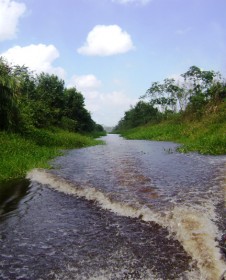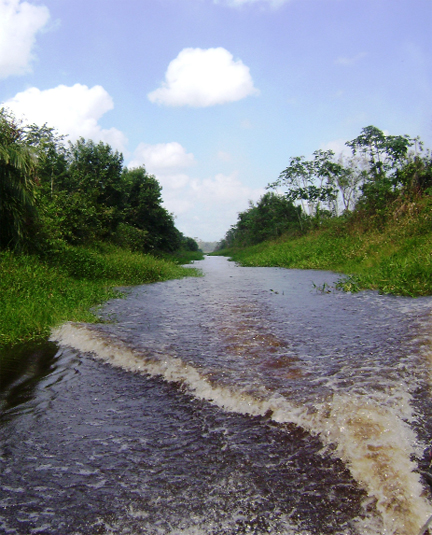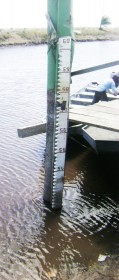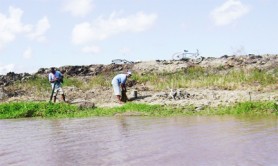-huge agri losses projected
With El Nino now forecast to last until mid-April and the next rainy season, months away, the agricultural sector is facing a potential $3 billion in losses.
And Agriculture Minister, Robert Persaud says that the ministry is “overstretched” as it tries to counter the drought-like conditions countrywide. Government spokesman, Dr. Roger Luncheon had last week warned of a water shortage and levels in the conservancies are the lowest in years as El Nino continues to grip the country and region. Currently, 10,000 acres of rice-lands are threatened, Persaud said during a tour of the East Demerara Water Conservancy (EDWC) yesterday.
He had also told farmers at Fairfield, Mahaica that the Ministry has mobilized its equipment with all pumps and excavators being put into operation “so much so we find we are out of capacity”. The farmers had complained about limited water availability for their crops, as well as for livestock.
“The situation is very severe”, said the Minister, adding that efforts are focused on minimizing losses. Thus far, he said, 10,000 acres of rice fields are under stress, with other crops and cattle too, being under pressure. Stating that the ministry is overstretched at the moment, he said that in deploying equipment, the Ministry has had to make decisions as to which areas are more critical. He appealed for farmers’ understanding emphasizing that there is no idle capacity.
He declared that ongoing efforts are aimed at preventing losses of as much as $3B. However, the Minister expressed confidence that the losses would be minimized. He noted that the Ministry was making several interventions including the construction of a canal leading from a creek to the Perth/Baiboo canal in Mahaica, on which a number of farmers depend. In other areas across the country too, the ministry is working and sparing no effort, he noted.
The Minister also called on farmers to desist from damaging drainage and irrigation structures in an effort to get water to their crops, stating that this is occurring and though their desperation is understandable, they must be restrained. He noted that the Ministry has teams out in the fields and farmers can raise their issues with them. In responding to the concern of one farmer, he stated that a “wave” of food and other interventions for cattle will begin today.
The Minister told reporters that the latest report from the Hydromet Department is that El Nino is expected to last until mid-April. It had previously been forecasted to last until next month. However, Persaud pointed out that the dry period is expected to last longer as the next rainy season begins in May. He noted that February is usually the driest month of the year. Last month recorded lower than average rainfall.
Yesterday, the water level at Flagstaff on the EDWC was 51.65 Georgetown Datum (GD) dropping from Friday when it was 51.75 GD. In a normal year, at this time the water level would have been at 57 GD. Water levels are dropping daily and it is the lowest he has seen, since he began working, five years ago, one employee told this newspaper. Sections of the conservancy have over time been widened to enable it to hold more water. Now, the water is a brownish-gray colour when it is normally clear and dark. At one section, the depth of the water was negligible and the boat used to transport journalists had to slow down and proceed cautiously. The operator said that due to the shallowness, two engines had been lost.
The National Drainage and Irrigation Authority (NDIA) is operating two pumps at Maduni to bring water into the EDWC while three pumps are discharging water from the EDWC into the regulated system; two for irrigations purposes, while the other is at Nancy Point for the Lamaha Canal, which supplies Georgetown. The one at Nancy Point is running on a 24-hour basis to ensure that there is an adequate supply for the city, Persaud told this newspaper. Water utility, the Guyana Water Incorporated (GWI) has already started reducing water flow in the city during off-peak hours and has warned citizens to conserve.
Persaud yesterday too emphasized conservation noting that to operate the equipment is costly. Close to $22M is being spent weekly on this, he said. He said that in some case, the Guyana Sugar Corporation was letting salt water into the system for navigation purposes. Thus far, he stated unlike some other countries, Guyana has been able to manage the situation and the pumps will run indefinitely. The last El Nino experienced here was in 2002 and this year’s occurrence is much more “impactful” because there is a greater area under cultivation, Persaud said.


Dr. Luncheon had also warned of an “involuntary” reduction in water supply noting that irrigation water availability is significantly threatened as is the surface water that provides as much as 50% of potable water consumption in Georgetown. The Ministry has said that over $250M has been expended since the El Nino phenomenon began last year. The current level of the EDWC is below the lowest design safe level for irrigation which is 53.50 GD (dead storage level). Whenever the water level gets below dead storage level, the flow of irrigation water by gravity becomes difficult.






